COLLECTIONS ― Fountain Pen
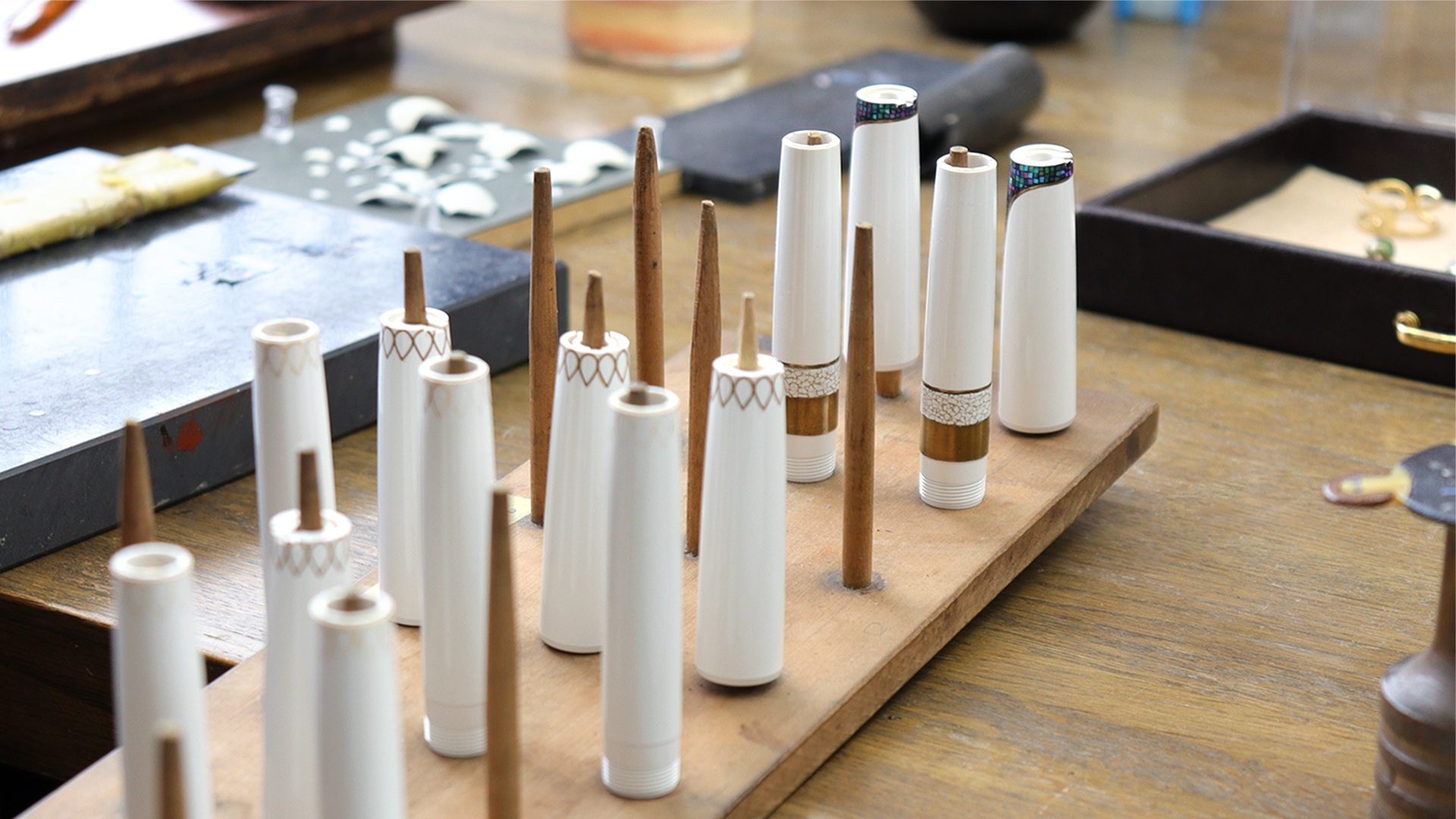
Classic Ko Fountain Pen and Ballpoint Pen are created by integrating traditional Maki-e crafting techniques with a contemporary look and feel.
Sailor Pen has a long-standing relationship with the Oshita Kosen Atelier, and the innovative collaboration that came to life in 2020 with the atelier’s Maki-e jewelry brand, Classic Ko, has developed into a series, bearing these uniquely beautiful writing instruments which are a world apart from the traditional image of Maki-e writing instruments.
We interviewed Oshita Kosen Atelier’s fifth-generation head, Kosei Oshita, who is also in charge of Classic Ko’s brand direction.

Maki-e is a Urushi (Japanese lacquer) art style unique to Japan and is a style iconic of Urushi art. This style was born approximately 1,200 years ago with a heritage dating back to the Nara Period. It involves brush painting illustrations and patterns with Urushi, and before the Urushi dries, Maki-e powder (metal powder such as gold or silver) is sprinkled onto the Urushi to decorate the art. Due to the way metal powder is sprinkled (“maki” in Japanese) onto the painting (“e” in Japanese), this art form came to be called “Maki-e”. There are styles of Maki-e that also use pieces of mother-of-pearl and egg shell.
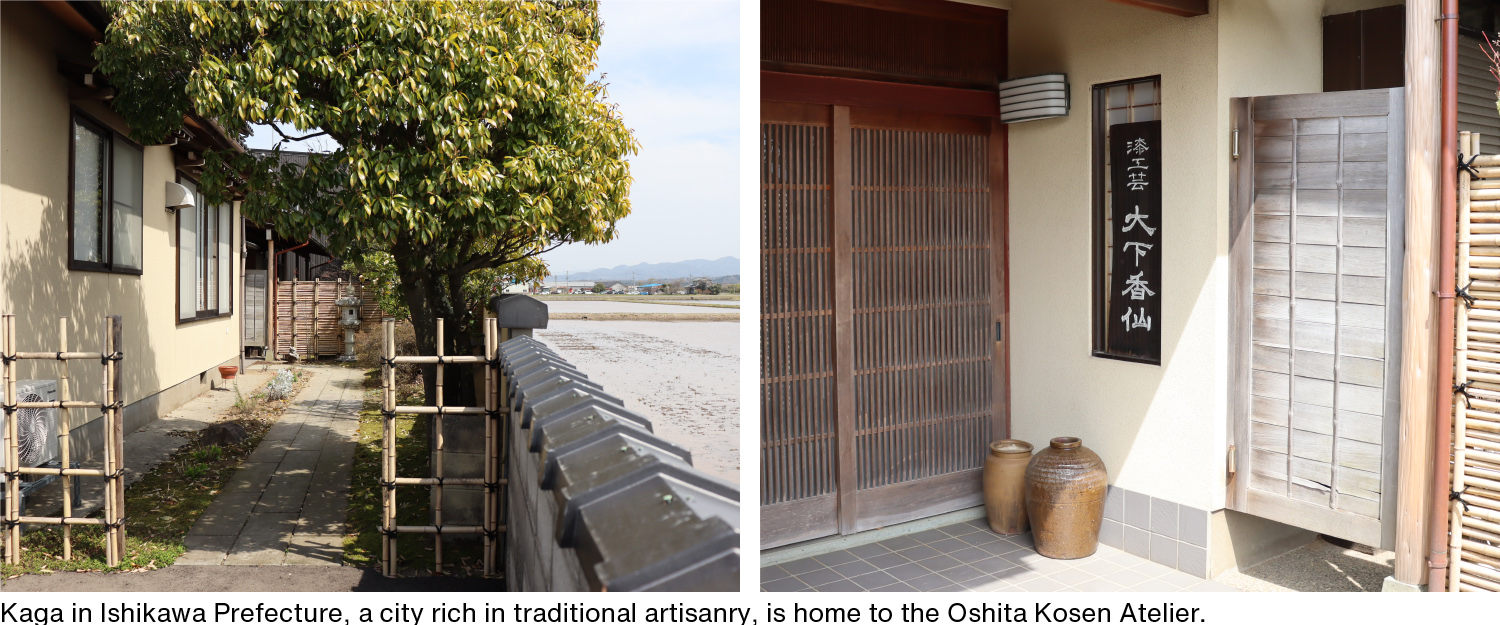
Please tell us about the jewelry brand, Classic Ko.
Classic Ko is a Maki-e jewelry brand that utilizes various Kaga style Maki-e crafting techniques traditional to the Hokuriku District of Japan, designed with a contemporary taste. Our jewelry is crafted at the Oshita Kosen Atelier which has a history of 130 years in producing fine tea ware and arts and crafts. We are an end-to-end business handling everything from jewelry design, crafting and production including processing pearl oyster shells, brand direction, all the way through to sales.

What are Oshita Kosen Atelier’s primary products?
Up through the times of our fourth-generation head, our atelier crafted mainly traditional items such as tea ceremony related products including tea ware, Natsume (tea caddies) and incense containers, as well as fine arts and crafts such as Inrou (mini trinket case) and Nezuke (strap charms for Inrou). We also engaged in developing designs for and the decorating process of fine Maki-e writing instruments.

The long-standing relationship between Sailor Pen and the Oshita Kosen Atelier began in 1981, when your father-in-law, Soko Oshita, was the fourth-generation atelier head. The first piece we created together was the Maki-e Fountain Pen Bird and Flower.

Maki-e art began with the ancient Japanese Yamato-e style painting, but our atelier’s Maki-e often featured casual design motifs such as owls and autumn grass, which are familiar and close to Japanese hearts, and this left an impression on me. On another collaboration project with Sailor Pen, I was struck by how a female Japanese style painter’s painting was expressed not on a conventional black background, but on a background of white, and even integrated a Ganesha (elephant-headed Hindu god) motif into the Maki-e design to delight customers in India.

Until recently, your atelier primarily provided traditional Maki-e crafting on Sailor Pen fountain pens such as those of the Kaga Taka Maki-e Fountain Pen Castle and Landscape and the KOP Ebonite Maki-e Shirei Series Fountain Pen Phoenix with design themes such as Sansui (scenic beauty of nature) and Shirei (the 4 mythical creatures).

Could you please tell us what led you to start up a jewelry brand from your Maki-e atelier?
The brand Classic Ko was launched in 2008. Between 1999 – 2003, we saw an increase in decoration orders for Maki-e fountain pens for markets outside Japan, with creatures from foreign myths as design motifs. And the traditional Japanese Maki-e items we used to decorate until then such as tea ware, were no longer receiving much attention. That was when we began to think about what we should be crafting in order to keep the appeal of Maki-e alive. We arrived at the vision that we needed to produce products from start to finish and be responsible through to their sales. After considering what items would realize our vision, Classic Ko was born.
What is behind the brand name, Classic Ko?
Ko comes from the pseudonym “Ko” (Kanji character meaning incense) which has been passed down through the generations as part of our names since Sekko Oshita founded the Oshita Kosen Atelier, and we paired that with the word “Classic” because it expresses the value we seek to create with top-notch items that withstand the test of time and remain unswayed by trends. Our aim is to build a brand that will be regarded as being classical 100 years from now.
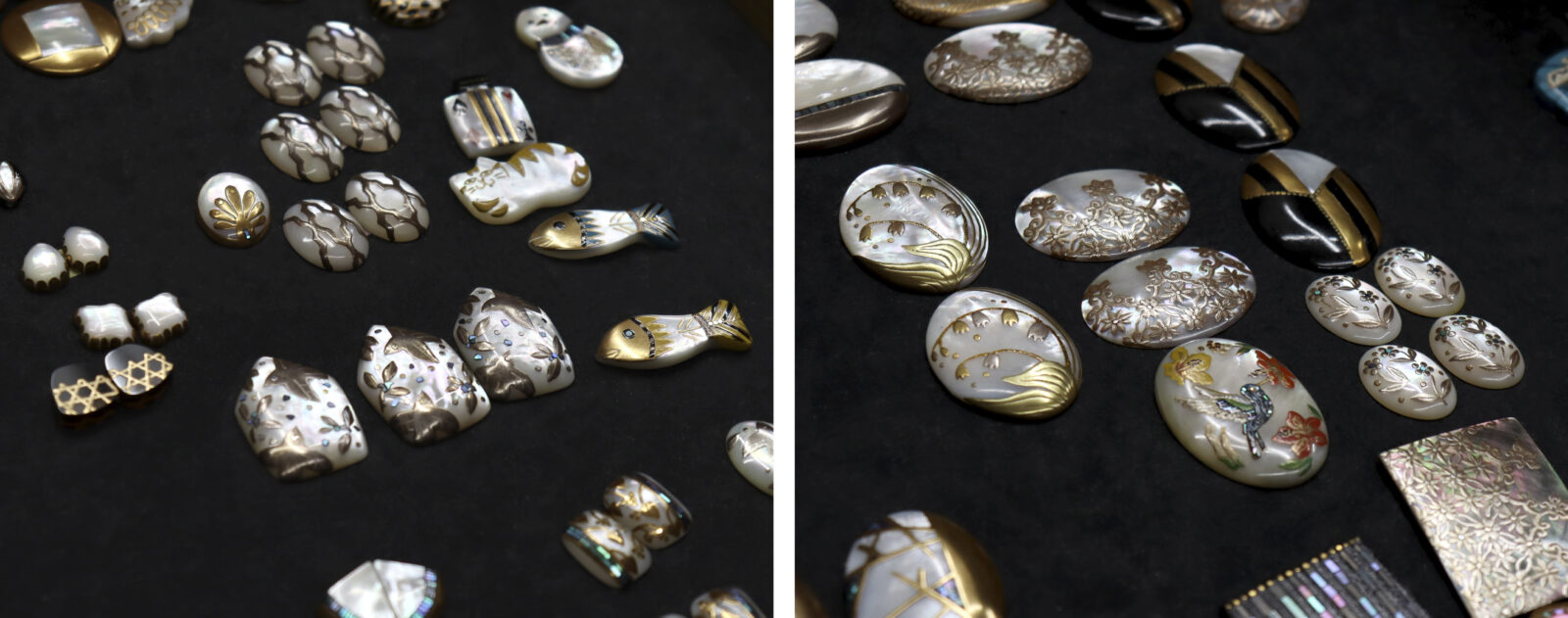
One of the charms of Classic Ko jewelry is the contemporary design. What led to the modern design concept?
Most Maki-e designs used to be traditional Japanese portrayals of the beauty of nature, with motifs such as flowers, birds, scenery and astral bodies like the moon. I appreciate such designs to be Japanesque, but for someone like myself, originally from Kanagawa Prefecture with a background in graphic design and having entered into the Oshita family by marriage, I wondered if there was a way to update the traditional taste of Maki-e to create items that resonate with the modern times. It was my fervent wish to change the outdated, stately image of Maki-e and increase the number of people interested in Maki-e. A good part of that wish stemmed from my own agenda to delve deeper into creating items with Maki-e, in a direction that I had true interest in. It was also influenced by the work we did on the fountain pen designs for markets outside of Japan, which was before we started up the Classic Ko brand. The design motifs were of foreign cultures, but by expressing them with Maki-e, the designs took on a Japanesque taste as well, and such fusion designs turned out very intriguing. That triggered and inspired the creation of Classic Ko’s brand realm, like a blend of cultures, such as the exotic feel of Middle Eastern designs or East-meets-West type of taste.
Designs are individually developed by each of our atelier designers with a shared understanding of the image we aim to create, under 4 main themes – cute pieces that tell a story, simple pieces that bring out the most of the materials used and go well with various fashion styles, art-deco-like pieces featuring classical expression of plants and pieces featuring flowers in elaborately ornate designs.
We ourselves get very excited during the creation process. We truly enjoy our work and amaze ourselves often with the designs born, like “Wow! Look how this turned out!”.

Other than the design, are there other aspects you are particular about?
Yes, we’re particular about wearing comfort. When we were producing mainly tea ware and fountain pens, we were more focused on how to facilitate the Maki-e process on such surfaces, as well as making the designs stand out, but with jewelry, we also pay careful attention to different aspects such as – is the piece easy to put on, is the weight of the piece appropriate, how much will it stand out against clothing and how will it highlight the wearer? Of course, we also take into account the structural aspects of jewelry, so for example, after polishing the Maki-e, we glass coat to heighten durability, and we also develop original clasps to ensure utility and comfort.
Another thing we are particular about is the use of natural materials for the Maki-e base. We do use Urushi as a base at times, but we mostly use natural materials like amber, pearl oyster shells, black-lipped pearl oyster shells, quartz and turquoise. We like to choose materials that have a very natural look, so for example, in choosing transparent quartz, we would look for a piece that naturally has a bit of cloudiness. In choosing materials and developing designs, we also like to purposefully leave a stone’s natural surface as is, in order to showcase a natural appeal that differs from machine-made items.
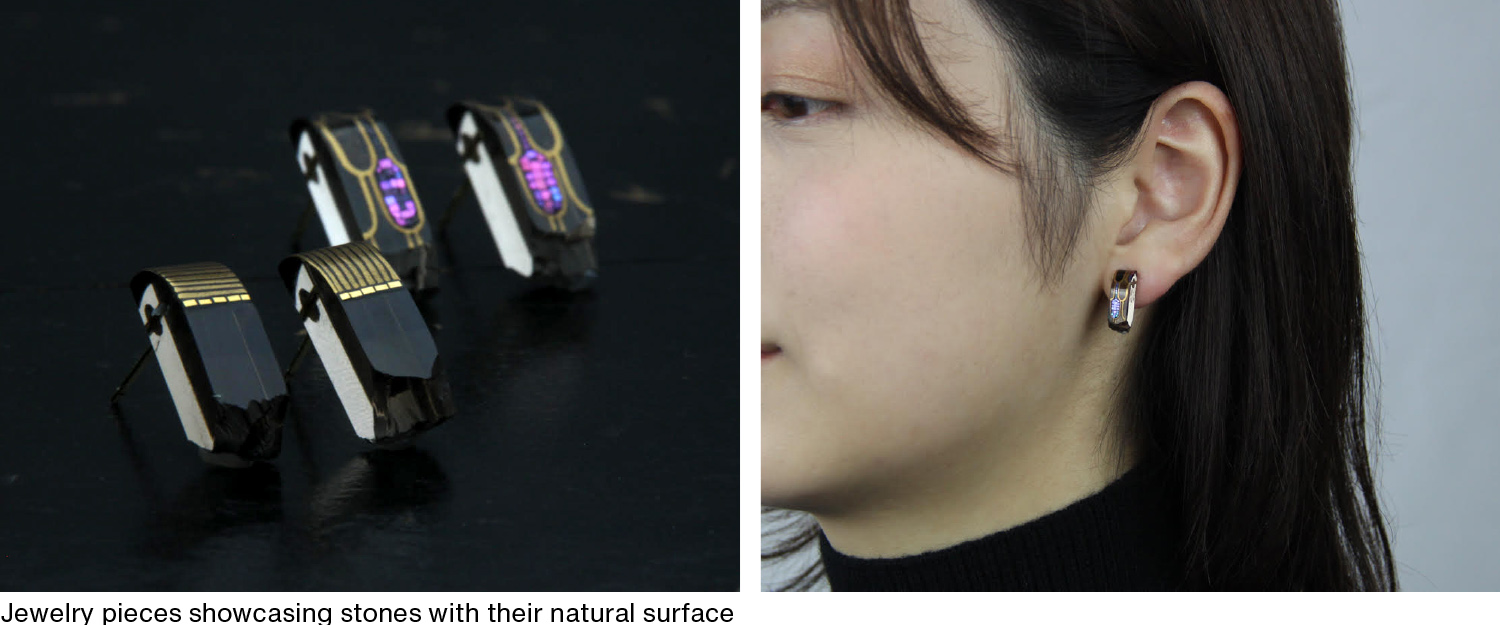
Please tell us about the Maki-e process that went into crafting the Classic Ko Maki-e Fountain Pen Floret Dot SV.
(The complex process is explained visually below.)
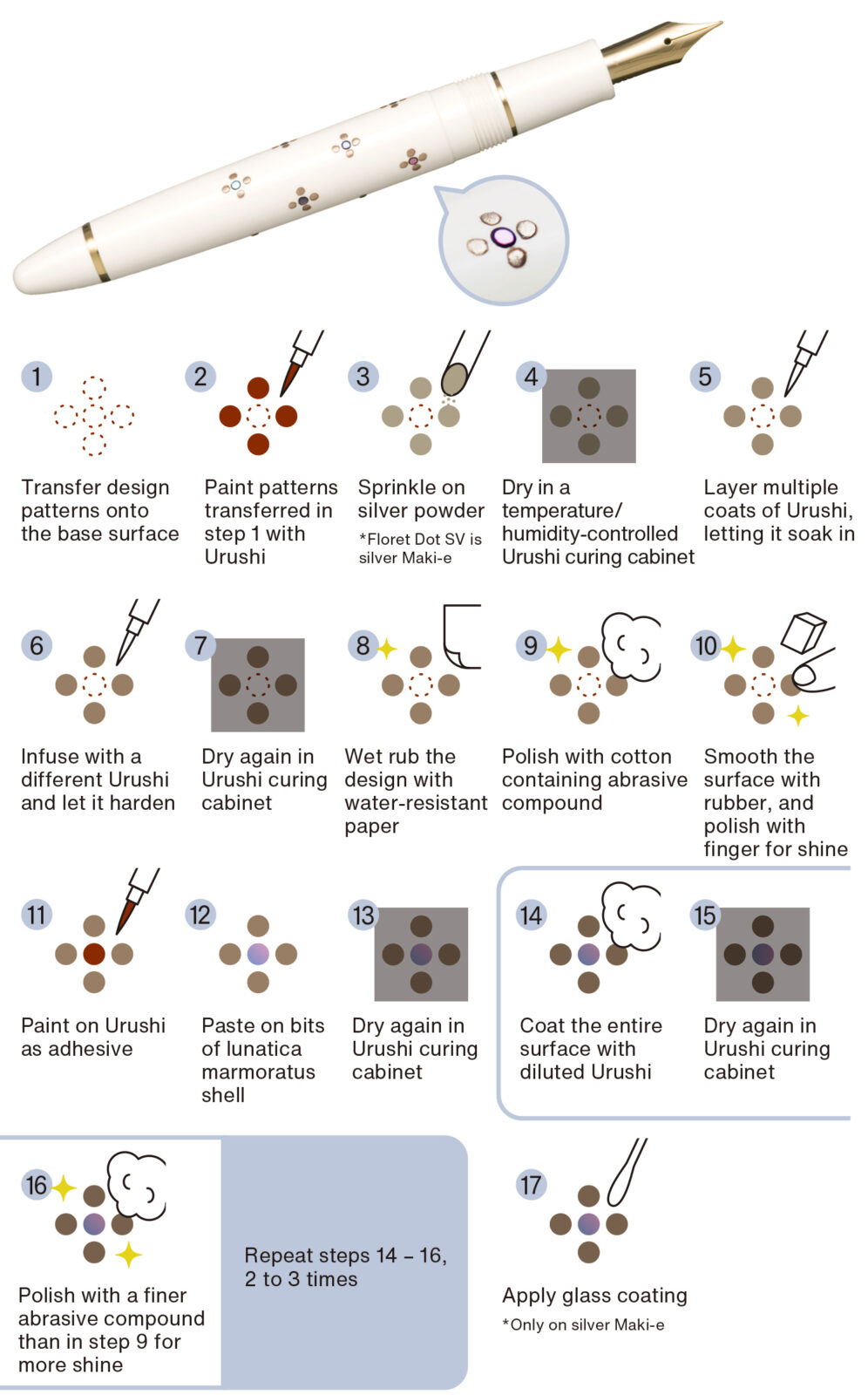

It’s amazing how all the many steps are done by hand. It must have been a very painstaking process, pasting Raden pieces onto the Classic Ko Maki-e Fountain Pen Deco Lotus Line Raden!
Yes, it was a very time-consuming process. The Raden pieces are procured in arc-shaped sheets, so we needed to first cut individual square pieces from the sheets and paste each piece onto the fountain pen’s surface. Shells shine in a particular direction, so if placed in the wrong direction, they won’t shine. And each piece differs in color, so we carefully examined the color and shine of each individual piece to decide the overall layout.
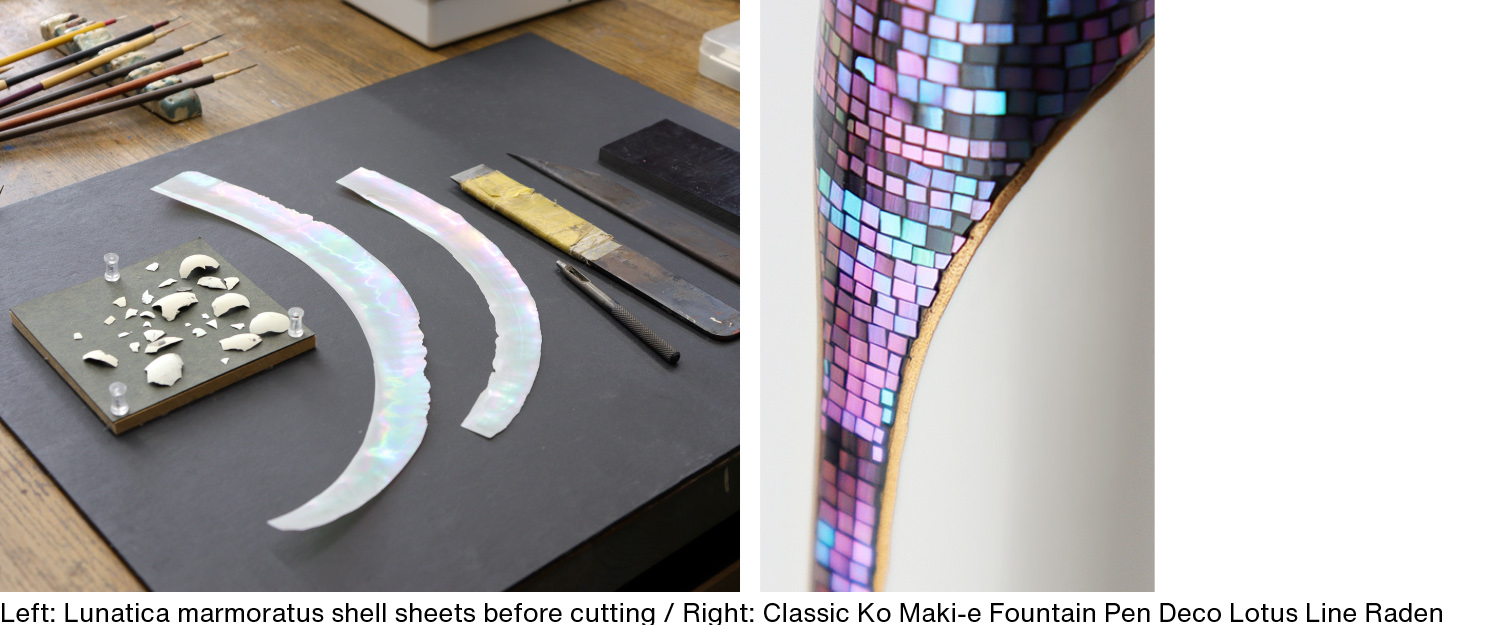
What is Raden?
螺鈿- Raden, is a traditional Japanese decorative technique that uses iridescent shells from pearl oysters or abalone.
This technique is employed to create intricate patterns and designs on lacquerware, and can be seen on items such as boxes, trays, and fountain pens.
The shells are carefully cut into thin strips or small pieces, which are then embedded into a lacquer base to form patterns, scenes, or geometric designs, giving a unique shimmer to the decorated surface.
This is a notable aspect of Japanese craftsmanship and is often used in high-quality traditional crafts.
What is the most difficult thing about your craft?
It really requires a lot of time and effort. We have to make sure Urushi has dried before going on to the next step so it is a slow process, and all in all, the craft is about continual effort and scrutinizing each step. Especially with our jewelry items, it’s more about the design and how to showcase the materials than it is about highlighting traditional skills. We place great importance on meticulously tending to the work with the utmost concentration, each day.
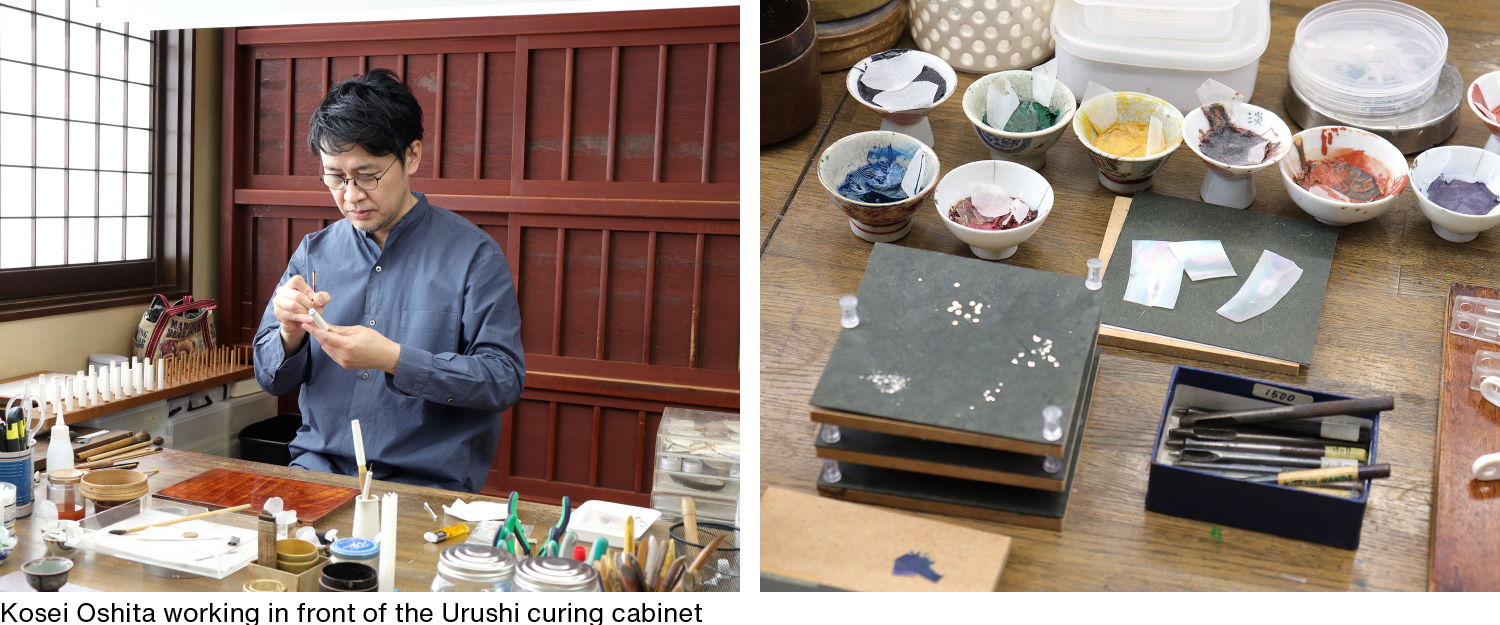
With solid traditional Maki-e skills passed down through the generations since the Meiji Period, the Oshita Kosen Atelier created Classic Ko Maki-e to suit contemporary lifestyles. This thinking was perfectly aligned with Sailor Pen’s pursuit of bringing innovation to Maki-e fountain pens, giving birth to the collaboration.
The Ala SV Fountain Pen that has just joined the collection, is a fresh challenge that combines a transparent body in the image of smoky quartz with Maki-e décor.
Enjoy the Classic Ko Makie Fountain Pen Series like jewelry, for fashionable elegance at your fingertips.
Classic Ko
2008 Classic Ko established as a Maki-e jewelry brand
2012 Produced accessories in collaboration with Sally Scott by designer Akira Minagawa
2013 Produced Suntory Hall’s gift (Key of Friendship) to the Vienna Philharmonic
2015 Helped produce Noritaka Tatehana’s “Theory of the Elements”
2020 Received an Encouragement Award in the Design Category at The Ishikawa International Urushi Exhibition
Classic Ko’s official website: http://www.classic-ko.jp/
Classic Ko items are available mainly via pop-ups at department stores and art gallery shops.
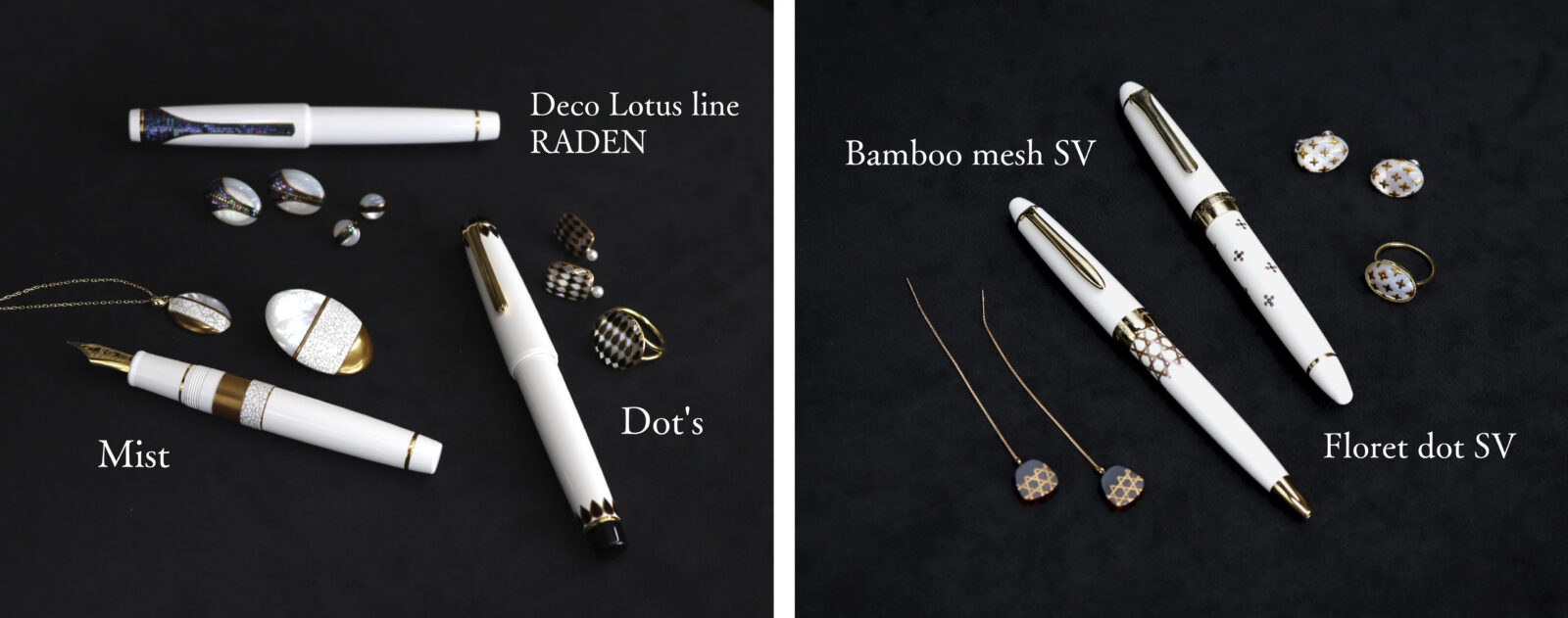
Classic Ko Fountain Pen/Ballpoint Pen products can be found here.
‘Classic Ko’ Fountain Pen DECO Lotus line RADEN
‘Classic Ko’ Fountain Pen Mist
‘Classic Ko’ Fountain Pen Dot’s
NEW ‘Classic Ko’ Fountain Pen Ala SV
